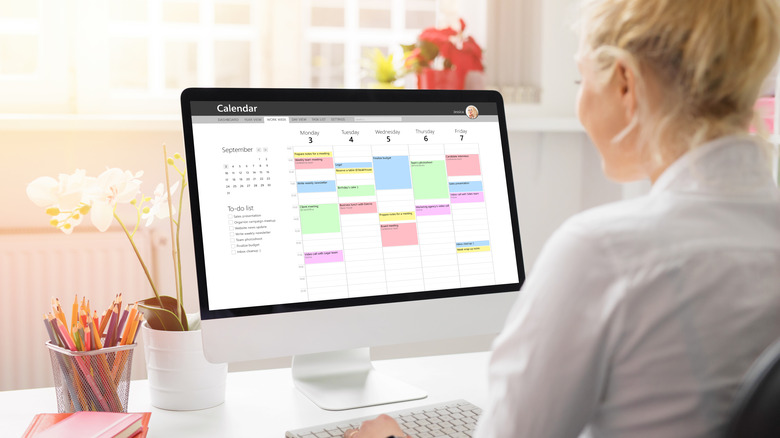Having A Solid Plan When Entering A Long-Distance Relationship Is Imperative. Here's How To Do It
There are many factors that will need to be taken into consideration when you decide to enter into a long-distance relationship. Where many couples go wrong is blissfully assuming that love and a vague idea of how the details might work themselves out is enough. While the notion that love is all you need is certainly romantic, it isn't practical enough to ensure that your long-distance relationship has the potential to make it for the long-haul.
You need a solid plan — complete with defined responsibilities and timelines — if you want to create a solid foundation for a love that can span cities, states, countries, or even continents. Where will you eventually live together? How and when will you visit each other in the meantime? These are just a few of the logistics involved in planning a successful long-distance relationship. Here's how to construct a plan that covers all your bases.
Set your intentions for the relationship
It is important for you and your partner to discuss your personal and collective intentions for any relationship. Through this discussion, you'll find out if one partner intends to start a relationship that will end in marriage or permanent cohabitation while the other simply intends to have a fun new cultural learning experience. If there is a lot of space between your partner's intentions and your own, it is best for you to know that information at the beginning of the relationship. Then, you can decide whether or not to proceed.
If you find that both you and your partner are looking for a long-term relationship, you can continue with the discussion of what that looks like for each of you. Together, you can decide on which aspects of the relationship take priority, how conflict will be handled, and at which theoretical point it would be best to go your separate ways.
Create a detailed plan for in-person visits
A relationship can only grow so much without spending time in person with your partner. In a long-distance relationship, you may find yourselves stuck in the early phases of partnership for a long period of time if visits aren't prioritized. Communication styles, lifestyles, and everyday habits can be experienced in a completely different way in person than they can be online or over the phone. Skipping the stage of regularly visiting and getting to know each other and rushing ahead to cohabitating could lead either of you to discover that you were only getting a partial picture of who your partner is from a distance.
While travel can be challenging both financially and logistically, it is worth it to ensure that you and your partner truly develop your relationship and discover each other in an organic nature. Simply agreeing to prioritize in-person contact is not enough. A detailed plan will map out your travel schedules for the next six months or more. Decide and note ahead of time who will travel for each visit, when it will occur, and how the trip will be financed.
Decide how and when you'll communicate
In a long-distance relationship, you don't have the option of coming home to your shared residence and catching up with your partner in person at the end of every day. There is no default contact, which means that you have to make a point of ensuring that you're staying in touch enough for both of you to feel secure in the relationship. Depending on your and your partner's intentions, this could look like checking in at least once a day, having one long virtual date each weekend, or staying in contact through most of every day.
Once you've agreed on a minimum amount of contact that meets both your needs, get detailed. Schedule dates ahead of time the same way you would if you were getting together in person. Decide ahead of time which platform you'll use to meet up virtually and who will initiate contact. Once you've agreed on dates and times, put them on your calendar and consider it non-negotiable. If a cancelation becomes necessary, be sure to reschedule your date as soon as possible. This doesn't mean you can't share spontaneous communication; it just ensures a baseline of meaningful interaction.
Schedule frequent assessments
All healthy and mature relationships require constant growth, communication, and assessment. In a long-distance relationship, it can be a little too easy to avoid uncomfortable conversations and let potential differences remain unaddressed. While this may provide more comfort in the moment, it can lead to devastating results in the long run. It is far better to experience discomfort now than to discover irreconcilable differences after you've invested even more time, money, and energy.
It is important to schedule assessments the same way you do dates and other communication. It is up to you and your partner to decide how often these relationship assessments will take place. Once you find the right frequency, prepare to discuss how you're each feeling about the relationship, each other, and whether or not your original intentions still apply. These check-ins will ensure that both of your needs are being met and you both continue to envision the same future.
Set an end goal
Long-distance relationships can be difficult and taxing when compared to the relative ease of an in-person relationship. As a result, most people aren't fulfilled by remaining in one indefinitely. It's important to not only maintain open communication about how you both envision the future of your relationship, but to set real tangible goals and timelines. Making the transition from a long-distance relationship to an in-person one takes extensive planning.
Once it becomes clear that you and your partner both plan to take your relationship to the next level, get specific about how and when that will happen. Decide whether your goal is to live together or to first live in the same city. Will one of you move into the other's existing home or will you live in a place that is new to you both? Work with your partner to create a plan that leaves you each with answers rather than lingering questions and leads the way to you both experiencing long-lasting happiness as a couple.





